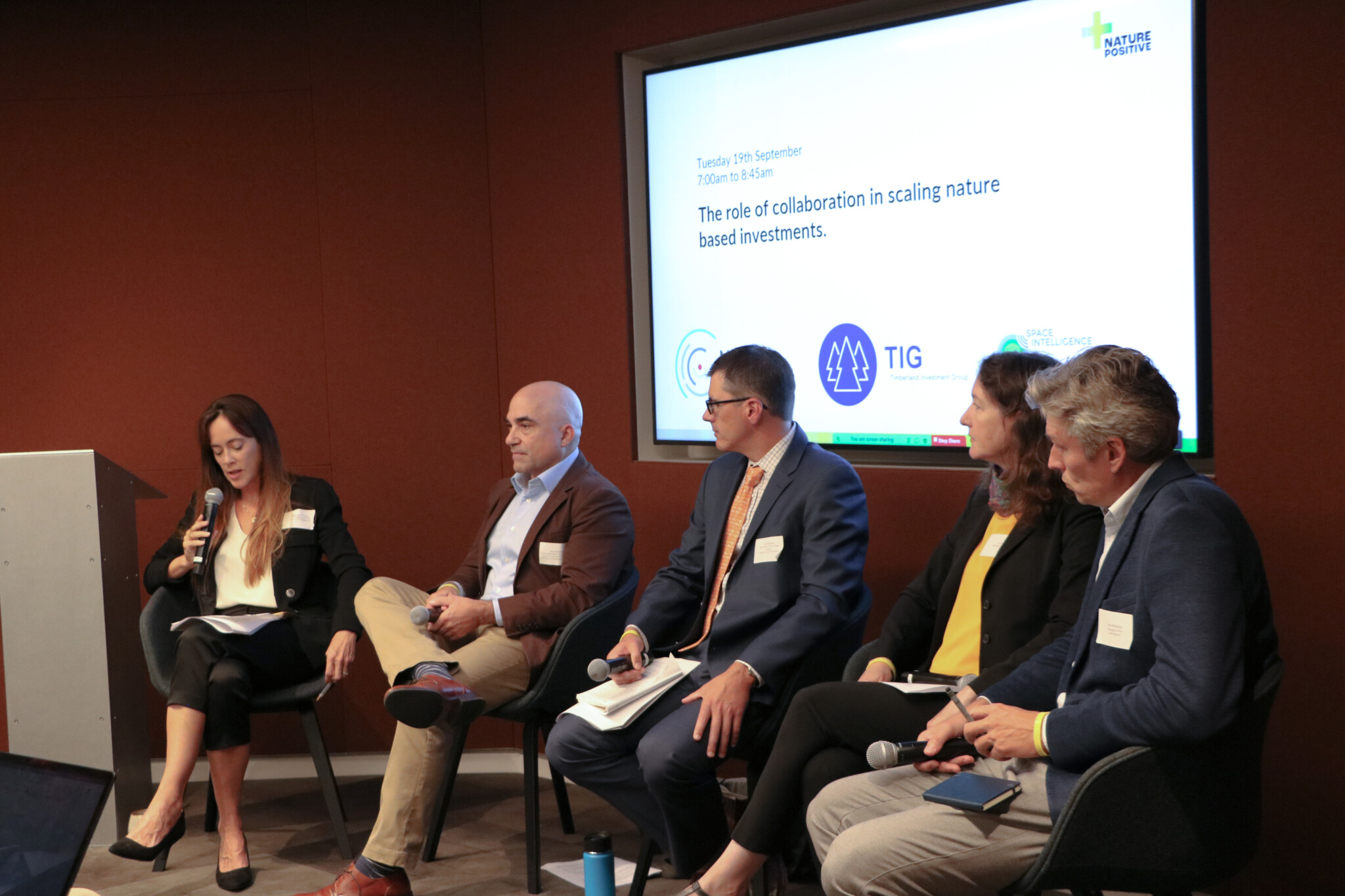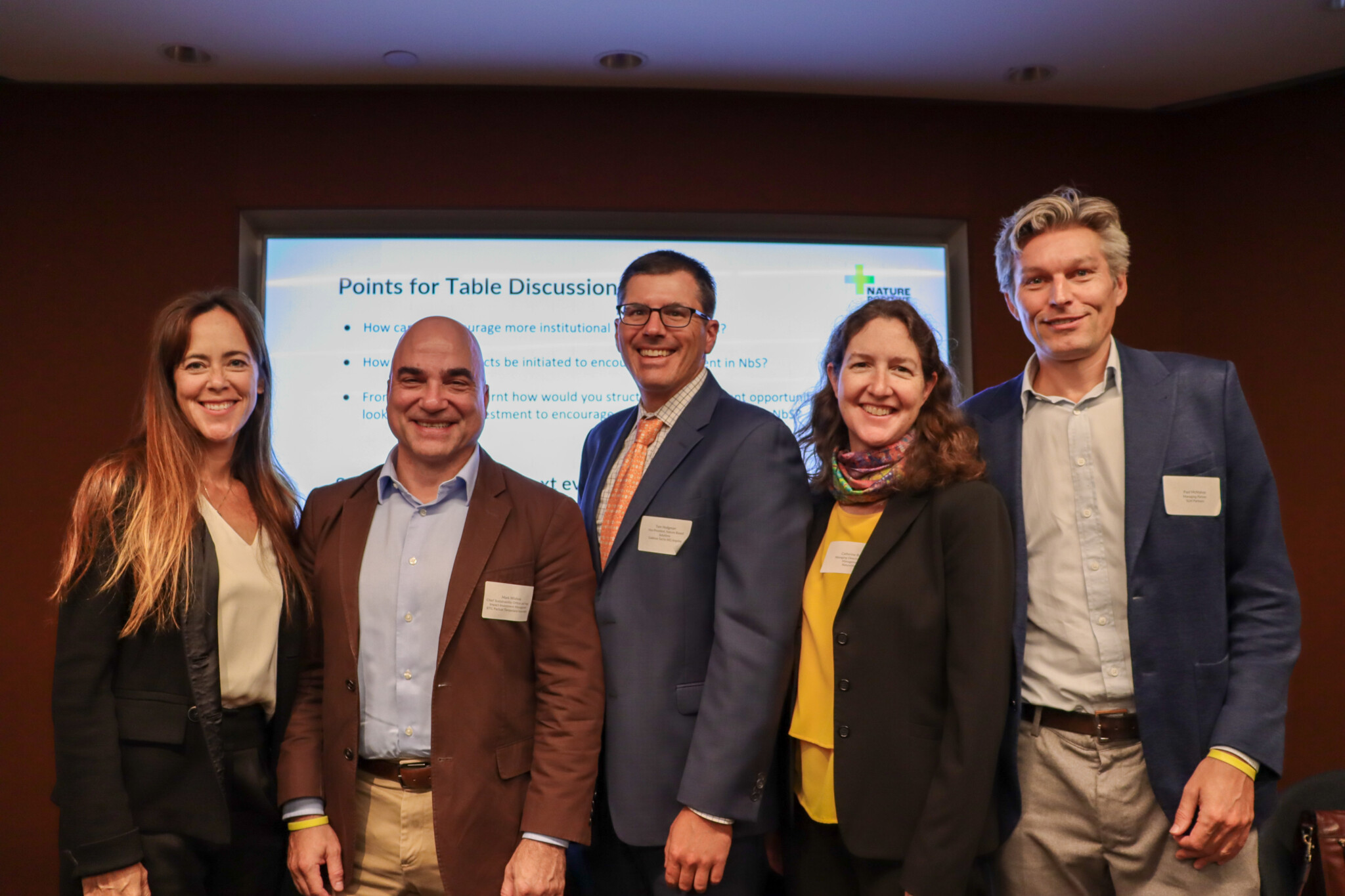Looking forward to COP 28: We need to see further collaboration in scaling nature-based investments

Photos: Kyra Althaus /Climate Advisers
COP 28 needs to see the finance sector step up with focused action plans to scale up nature-based solutions in ways that contribute meaningfully to reversing nature loss.
Collaboration between organizations – for example between investors and NGOs – has emerged as a crucial strategy in efforts to scale investments in nature. And at New York Climate Week, N4C ran an event that brought together investors and lenders leading the way in building successful partnerships.
From reforestation, to restoring groundwater aquifers, to changing agricultural practices, leading investors at N4C’s event explored why collaboration is a key tool in delivering high-integrity nature-based solutions (NbS) and how this helps attract significant investment. Highlights are detailed below.
BTG Pactual Timberland Investment Group’s collaborative approach
Mark Wishnie, Chief Sustainability Officer and Head, Impact Investment Management of BTG Pactual Timberland Investment Group (TIG), highlighted the surge in institutional commitments towards achieving net-zero emissions and fostering nature-positive outcomes, and the trillions of dollars in public funds now intent on hitting these goals.
With almost $5.2 billion in assets under management and a focus on the Americas, TIG is increasingly looking for opportunities to expand its nature-based investments to drive significant biodiversity and climate benefits.
Collaboration is at the heart of TIG’s approach, involving partnerships with entities like The Nature Conservancy (TNC) in the United States. This collaboration includes an impact management strategy centered on TIG’s core timberland portfolio, with a focus on building relationships with civil society, government agencies, and scientific communities.
In Latin America, BTG Pactual TIG collaborates with Conservation International (CI) on a 700,000 acre strategy aimed at restoration, protection, and reforestation across the Southern Cone of South America. This initiative tackles the critical task of protecting and restoring previously deforested land, with an equal mix of conservation and restoration efforts and the establishment of tree farms.
Scaling nature-based solutions with Goldman Sachs Imprint Team
Tom Hodgman from the Goldman Sachs (GS) Imprint Team emphasized the scale of the challenge in achieving the Intergovernmental Panel on Climate Change’s (IPCC) 1.5oC. Even if all 2030 existing commitments are met, an additional 24 gigatons in emissions reductions are needed to meet the 1.5 oC goal, and NbS have a substantial role to play in bridging the gap.
Hodgman stressed the importance of making NbS accessible to new investors, particularly those with a long history of investing in timberland and farmland. He noted that the timberland sector alone represents a private market worth $50 billion, exceeding $100 billion when public investments are included.
Tom emphasized that collaboration is a recurring theme for GS, exemplified by their management of the Apple Restore Fund. Apple’s $200 million commitment aims to achieve both financial returns and carbon sequestration by producing sustainable timber or agroforestry products. The GS Imprint Team also collaborates with Conservation International, which plays a crucial role in due diligence, carbon accounting, biodiversity management, governance, social programs, and management plans.
Nature-based investments at NatureVest
Dr. Catherine Burns, Managing Director of Impact Management for TNC’s NatureVest team, highlighted two types of nature-based investments; first: catalytic funds, that demonstrate new ways to create transformative systems change, and second: scaled investments, involving hundreds of millions to billions of dollars that can themselves deliver impact at large scales. She provided a compelling example of the latter in the form of the Sustainable Water Impact (SWIF) Fund, a NatureVest collaboration with Renewable Resources Group (RRG).
This fund focuses on sustainable water management to provide a more reliable source of surface and groundwater for people and nature. Dr. Burns provided an example from SWIF in which recharge of groundwater aquifers creates not only a revenue stream in the form of stored groundwater, but also creates valuable migratory bird habitat on the surface of recharge basins when flooded.
Another NatureVest initiative is the Africa Conservation and Communities Tourism (ACCT) Fund, managed by ThirdWay Partners and advised by TNC. The fund operates in sub-Saharan Africa to provide small to mid-sized loans to tourism operators with preferred terms – to support businesses that provide local jobs and contribute to long-term conservation efforts. TNC serves as the fund’s conservation advisor, helping to set and measure impact objectives, an approach that helped attract blended capital support from organizations like the US Agency for International Development to help de-risk investments.

Sustainable agriculture and forestry at SLM Partners (SLM)
Paul McMahon explained how SLM uses institutional capital to scale-up sustainable agriculture and forestry. He emphasized the importance of mitigating the negative impacts of conventional agriculture and forestry practices in addition to scaling finance to sustainable business models.
McMahon highlighted that real asset investing in sustainable agriculture is geography-specific and can generate steady financial returns, with carbon and other environmental markets providing upside. He noted this kind of investment model is more straightforward in Australia, where the carbon market is 10 years ahead, but similar schemes in the US and Europe are developing, albeit often on a voluntary basis.
Collaborations at SLM involve partnerships with local foresters and farmers, such as the buying and leasing of land to organic farmers in the US. Farmers initially pay a below-market rent, later transitioning to a fixed rent with profit-sharing.
In Australia, SLM has formed a joint venture with ImpactAg, known for its pioneering soil carbon projects, to combine mixed farming with carbon projects. Investors can enhance returns by generating carbon credits from soil carbon and tree planting. SLM also collaborates with specialized non-profits and service providers which focus on measuring carbon and biodiversity, such as the Ecosystem Service Marketplace Consortium in the US and Natural Business Intelligence in Portugal.
——————–
It’s clear we need to see more financial institutions step up and embark on similar collaborative projects. But how should they best go about this? N4C’s event culminated with a rich and varied discussion, chaired by Megan Reilly Cayten of Climate Asset Management, and landed on a number of key learning points for financial institutions keen to scale nature-based investments.
These included:
- Role clarity: Investing the time to define clear roles and responsibilities for each partner in a collaboration is critical for long-term success.
- Transparency: A commitment to transparency and evidence-based impact goals is crucial. There are several options for collaborating with NGOs and other organizations to ensure the delivery of biodiversity, climate and social outcomes.
- Shared language: Aligning the meaning of key terms across the sector (e.g., regenerative agriculture) can help the entire sector scale.
- Learning by doing: Investing in nature often involves learning and adapting as projects progress.
- Incentive alignment: When investments perform well, it’s essential to ensure alignment and sharing of benefits across all stakeholders in any collaborative partnership.
During the Q&A session, participants touched upon several key points, including:
- Collaborative fundraising: Participants discussed the potential benefits and challenges of collaborating in fundraising efforts.
- Technical assistance: Even with relatively small funds, substantial impacts can be achieved through collaboration. SLM Ireland’s 50-million-Euro fund, for example, was complemented by less than a million Euros in technical assistance from the European Investment Bank (EIB). Despite this small allocation, this initiative has brought about policy changes supporting continuous-cover forestry.
- Research collaboration: Collaborations extend to research, with examples like The Nature Conservancy (TNC) partnership with agricultural and renewables-focused funds to explore agrivoltaics, and Goldman Sachs-initiated collaborations with universities.
- Challenges of smallholder-focused strategies: The difficulties in attracting institutional capital to smallholder farmers were discussed, emphasizing the need for trusted partners, financial incentives, and supply chain intermediaries to facilitate change.
By facilitating the sharing of insights, resources, and expertise, the N4C finance event at New York Climate Week showed how collaborative efforts hold the potential to drive meaningful change and accelerate progress toward a nature-positive future. We need to see more of this at COP 28 and beyond.